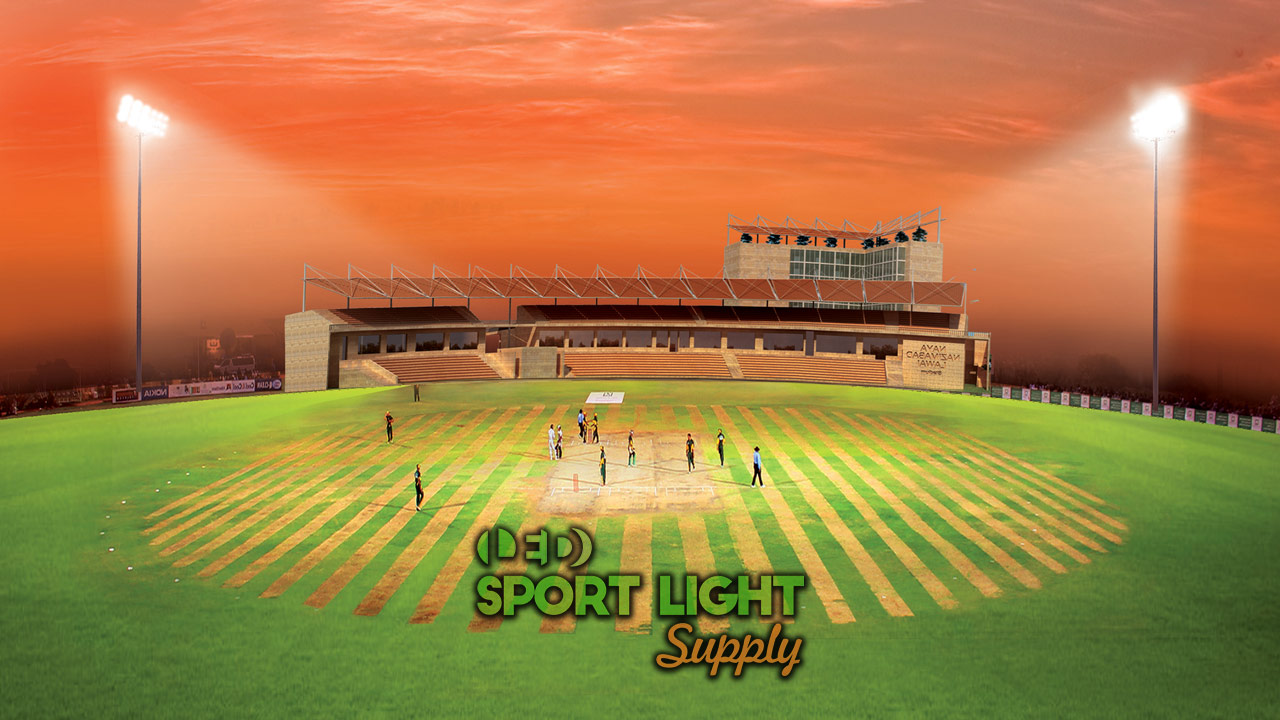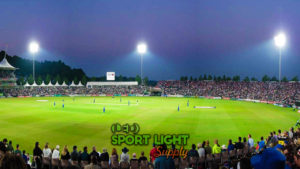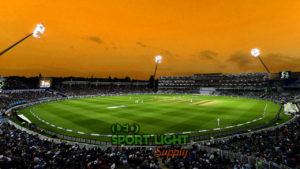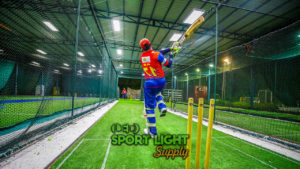As a spectator, it is easy to miss all the lighting details required for the oval cricket field. But, you probably recognized the use of the most widespread lamps called LED lights. Well, four different LED light sources are used to illuminate the cricket ground. So, prepare to learn all about the various lighting apparatus for cricket facilities.
Here is all you need to know about these four types of lights. But in the end, you will learn more than each name. For example, you will find out which light is more suitable to light the cricket pitch and what is for. I have gathered for you the most relevant info for selecting the right light for your pitch. Plus, the essential glossary terms and explanations. You do not need to know the cricket stadium lighting standard to follow along.
What are the names of the cricket field and stadium lights?
1. Floodlight
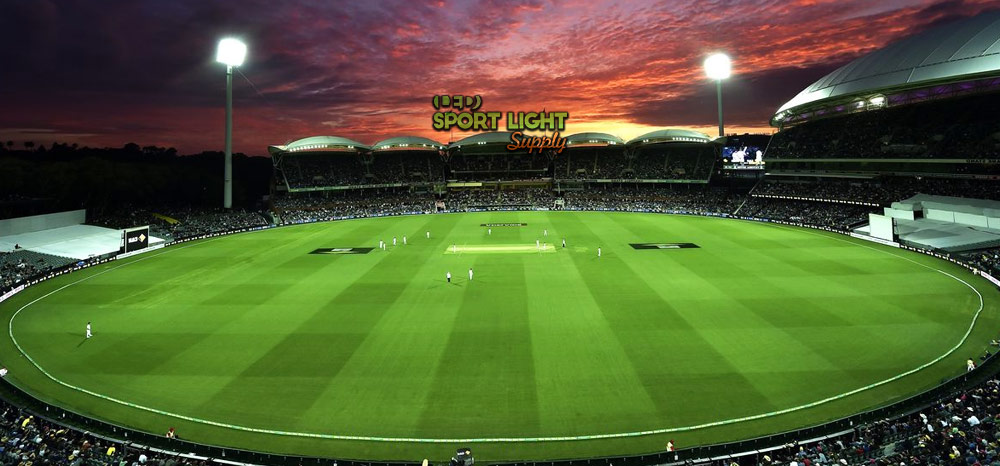
To begin with, the popular floodlight is a projector that emits a wide beam of light. Mainly, it is a high-power LED lamp inside a simple casing. It provides uniform lighting for the whole cricket stadium. Of course, it is used outdoor because of its intense brightness.
So, why do they call it a flood light? A floodlight casing contains a gloss lens and optical glass capable of creating a wide beam of light. When the innings start, its light floods both team players uniformly. In other words, the name relates to its bright, broad luminous flux.
Throughout the years, the floodlight models changed. They came with several inbuilt light bulbs. Some of which are called HPS and are energy hogs. Today’s floodlights have a portable design or can be placed inside bigger structures. Besides, you can install them on metallic brackets or frames.
2. Spotlight
The spotlight is extremely useful when it comes to long distances. Plus, it can focus on the wickets or increase the light distribution on the cricket ground.
In the outdoor cricket stadium, you can find spotlights in different locations. Mostly because you can install the lampshade holders pretty everywhere. I mean, in any place where it can safely connect to the electrical system. Size and dimension can dramatically change with different models.
Most LED spotlights still maintain the standard design. That is, a c-clamp that holds the structure, one or two plano-convex lenses, and lens train. The user can then choose a soft or hard focus of the luminous flux. Besides, shutters allow for more control of the unit’s beam.
3. High mast light
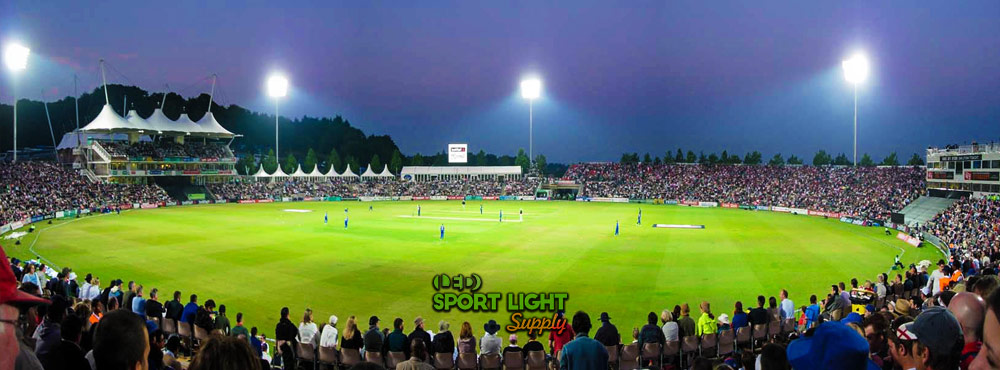
An outdoor cricket pitch relies on high mast lighting to illuminate most of the playing area. Above all, high mast lights are great because they provide horizontal and vertical lighting. At the same time, they can cause light pollution.
Moreover, high mast lights need lightning protection. A series of conductors must transfer the energy in case of a lightning bolt strike. Plus, lighting strikes pose a serious threat to spectators, bowlers, and batters. So, their location matters.
A lighting engineer or designer is also needed to calculate the mast height. Normally, no light pole is less than 25 meters tall. Indeed, the expert designs a lighting layout to meet the requirements. On average, each high mast contains several LED light sources at the top. Usually, they are aligned and tilted to provide better lighting uniformity on the cricket ground.
4. High bay lights
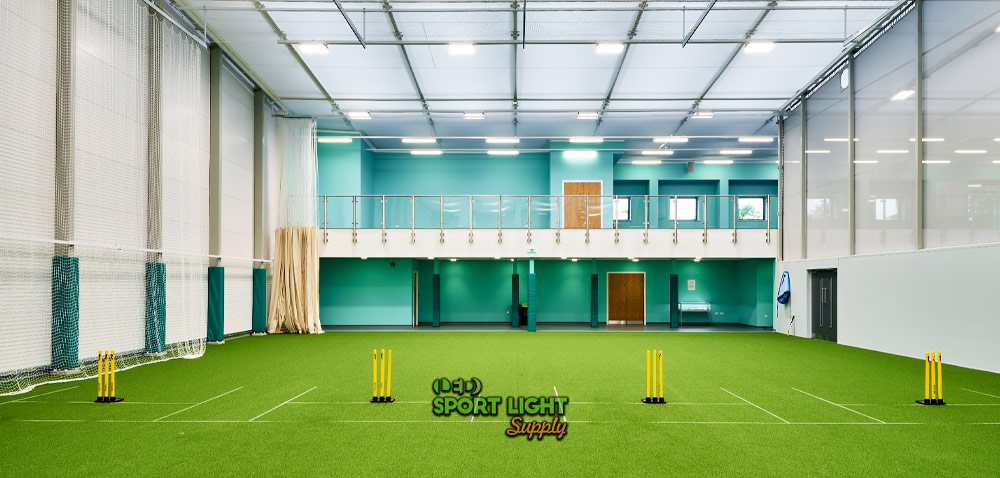
Any indoor cricket field uses high bay lights to brighten up the sports facility. Sometimes, these lights have a different name. In fact, you might hear them be called UFO, linear, or U-bracket high bay lights. These names refer to several models available on the market.
Today’s high bay lights use high-tech LED lamps to illuminate both the indoor infield and outfield. Usually, the cricket facility owner installs them on mounting brackets. But they can also hang from the ceiling.
The most common lighting layout uses many high bay lights in rows. Besides, they come in an almost standardized wattage. That is, ranging from 150 to 200 Watts. For bigger and taller cricket stadiums, custom made high bay lights might be necessary.
Floodlight VS spot light: which is better for the cricket pitch?
Here is a brief discussion about which cricket stadium light is more suitable and why. The main focus of this section is to explain what is their best use. As you can see, both the floodlight and the spot light fulfill different purposes on the cricket ground. But the latest LED models let you control the luminous flux. So, light control calls for more careful planning.
You can install both models to illuminate the cricket pitch. But here, we want to discuss which is better. In other words, we are going to explain some of the benefits of using only one of the two models or a mix of both.
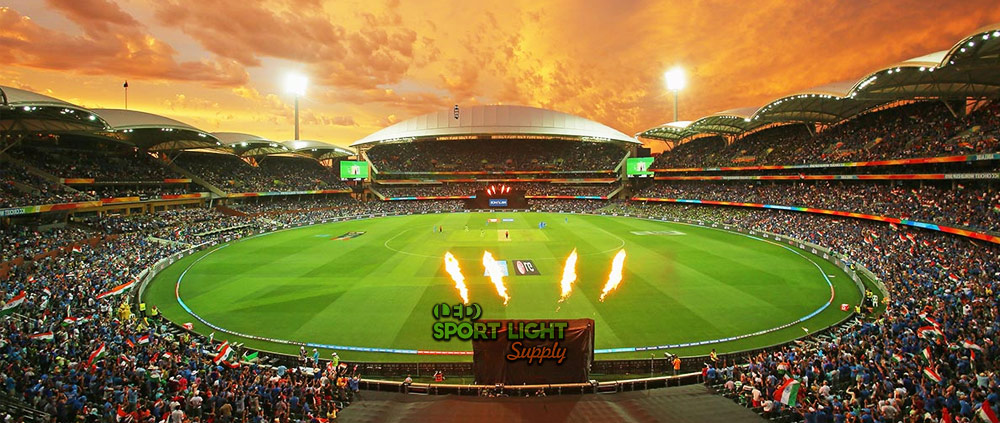
1. Cricket stadium spot lights
For one thing, spotlights are suitable for a large field and long-range (infield) use. Mostly because of the small beam angle. The light beam can travel to a longer distance while maintaining the desired brightness or lux level.
Sometimes, you will need to use a narrow beam of 10-degree or less. For example, to keep the maximum uniformity gradient in check. Spotlights let you do that because you can control the beam angle via the inner shutters.
In simple terms, cricket stadium spotlights are great to adjust to any cricket ground lighting condition. You can use more spotlights at once to get a convincing floodlight effect. And you can point them to specific cricket field areas to increase the illuminance on the playing area.
2. Cricket field flood light
Unlike spotlights, floodlights are suitable for a small to medium size cricket field. Mostly because of their large beam angle.
Ordinarily, practice wickets floodlighting use 45 to 60 degrees angles. Cricket field floodlights are also useful for television broadcasting. Moreover, they help to get the best lighting tech parameters for horizontal and vertical illuminance.
On the negative side, they can cause glare and sky glow. So, it is better to follow strict rules or standards like the EN12193 or the IESANZ LG-4.01 for outdoor cricket.
In practice, flood lights are the best solutions for modified cricket fields. Besides, you can use them in any training or sports facility that hosts different levels of competition. You can arrange them into groups to turn them on and off for a quick adjustment in relation to the varying field size being used.
3. Mixed
First-class venues require a mix of both light fixtures. Most of the time, experts suggest you use both flood lights and spot lights at the same time. As you can guess, you install flood light for short-range (to light the outfield) and spot light for long-range lighting (close-infield, the rectangular center of the round cricket field, also called circle).
The main benefit of a mixed design is the better illuminance distribution. Above all, you get full control of the illuminance levels for more pleasant lighting conditions. That is, both for the participants, officials, and spectators. With the correct lighting uniformity, the risk of glare decreases significantly. At the same time, if you use LED lights, you can still get a realistic color rendering effect.
Nomenclature, terms, and glossary of cricket ground lights
1. Lens
The lens is the transparent cover in front of the LED bulb. Mainly, it protects the LED bulb and can change the shape or the beam angle. The beam angle depends on the design and curvature of the lens.
The most common material used for the LED lens is polycarbonate. This material also offers UV protection and can be used in conjunction with other types of lamps. Usually, a secondary lens helps to focus the beam of light while reducing spill light at the same time.
Glass and silicone lenses are also available. In particular, a liquid silicone lens can withstand high temperatures, so it is suitable for a LED chip drive. A glass lens resists corrosion, but it is heavier, and it has more cons than pros.
2. Beam angle
Each light fixture comes with a beam angle. That is, the full-width of the luminous flux. For instance, LED flood lights produce a wide beam angle.
You can find floodlights or linear high bay lights with 120-degree beam angles. But for a cricket field, you will probably need up to 40- or 60-degree floodlights. Mostly because a 25-degree angle from the center of the cricket oval to the high mast is ideal for a comfortable vision.
Televised games require the best lighting conditions, so the beam angle becomes essential. Also, higher mounting heights help to achieve the most suitable lighting criteria. These two factors go hand in hand and apply to both flood lights and spotlights.
3. Color temperature
Color temperature is measured in Kelvin degrees and refers to the lighting quality. Most likely, you already heard of cool and warm light.
What is meant by warm light? It is a light that has a color temperature below 3,300 degrees Kelvin. Typically, bulbs with a warm glow have a color that ranges from red to yellow. Within the 3,500-5,500 K spectrum, light is called neutral light. As the name implies, the color is whitish.
Finally, here is what we mean by cold light. It is a light that has a color temperature between 5,500 and 6,500 degrees Kelvin. Usually, cold light bulbs have a color ranging from white to blue. And because of this blue tint, most people associate them with a cool hue.
4. Lumen
The lumen is nothing more than the unit of measurement of the luminous flux. More precisely, it indicates the visible amount of light emanating from a source (for example, a LED flood light).
Compared to other values, such as the size of the cricket ground, lumens tell us how much light you need for that particular field. The acronym that indicates the lumen is LM.
The higher the lumen output, the more brightness the light source emits. Lastly, lumens are necessary to calculate the required lux level for cricket activities.
5. Lux
This unit of measurement of brightness expresses the amount of illumination created by one lumen per square meter.
Unlike what you might think, there is no rule or mathematical formula that allows you to convert lumens into Watts or vice versa. So, trying to find a way to standardize the brightness in a cricket stadium can be challenging. That is when the lux levels come into play!
First, an organization decides the lighting standard for a professional or rec sports activity. When they settle on a lux level for each activity, the cricket clubs must comply. To do that, today’s cricket stadium owner must use a lux meter to be sure that the lighting efficiency reaches the minimum lux value necessary.
6. Lighting uniformity
The lighting uniformity is a precise parameter. It is defined as the ratio between the minimum and the average illuminance on a given surface.
You divide the cricket ground into smaller areas by using a precise layout, also called an illuminance grid plan. Basically, you follow the same principles for both indoor and outdoor cricket playing field lighting. Many lux readings are necessary to get to this value in the name of playability. In detail, the need for this value to be met relates to both safety and security measures.
For instance, when entering the batting cage for training, a wicket-keeper must be able to see the ball. But the player also needs to avoid holes in the ground to reach the batting position.
7. CRI and TLCI
Light distribution should be balanced with directional lighting. That is, several light bodies illuminating from specific locations. After all, the main goal is to improve the three-dimensional recognition of objects.
But how you perceive the colors can also influence how you react on the field. Your behavior changes because of the quality of the artificial light. So, you use a Color Rendering Index (CRI) to gauge how well a light source illuminates an object. The higher this value, the more natural it looks.
Light does more than creating a shading in which you pass from dark to light areas. With better color rendering, each shape is revealed in a clear and pleasant way. As you can imagine, this factor is of uttermost importance when it comes to broadcasting. So, professional cricket stadium flood lights use a TLCI rating system. TLCI is a rating system created for lighting used in televised coverage of cricket games. High TLCI scores are ideal for television broadcast.
8. LED driver
Another name for the LED driver is switching power supply. Just like the transformer, the power supply of LED lights provides a steady DC current to LED chips. LED lights cannot directly use AC, so they need a driver to convert the electricity from AC to 12V/24V/48V DC.
In simpler terms, a LED driver has the task of converting the alternating current of the electrical network into a direct current at a constant value. As you can imagine, this issue is not a trivial one, so high-tech LED drivers make a clear-cut difference.
Various lighting applications require many different types of drivers. Therefore, you can always consult an expert to find the most reliable cricket stadium light sources. If nothing else, because this tech is continually evolving.
9. Diecast aluminum
As you shop for cricket field lights, you might notice that most fixtures are made of rigid aluminum diecast. This is the most common material of the lamp body. It has many advantages, such as:
- anti-corrosion
- high durability
- light-weight
- robust
- good dissipation of heat
Aluminum is also malleable. So, it is easier for the manufacturer to create custom made floodlights or spotlights. For the best results, always ask your contractor for LED products that meet your specific needs.
Conclusion
You now know more than the name of each cricket stadium light. Plus, you read about the indoor cricket ground flood lights called high bay lights. They are what is needed for your cricket pitch, and manufacturers can help you find more personalized solutions.
LED diode lighting has been booming in recent years. Today, we can safely say that they have completely replaced standard light bulbs on the cricket field. This is not only because it is a very versatile tech but also because it manages to offer a better alternative. These light sources are easy to install, consume less energy, and therefore have a lower environmental impact.

